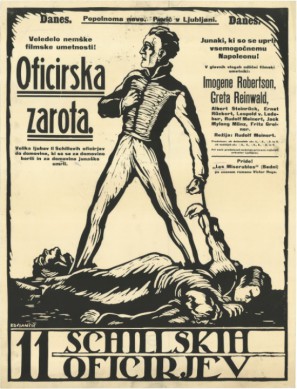Related Research Articles

Carl de Vogt was a German film actor who starred in four of Fritz Lang's early films. He attended the acting school in Cologne, Germany. Together with acting he was also active as a singer and recorded several discs. His greatest hit was "Der Fremdenlegionär". An extremely successful actor in his early career, he died in relative obscurity in 1970.
Kammerspielfilm is a type of German film that offers an intimate, cinematic portrait of lower middle class life.

Robert Reinert was a German film director and screenwriter.

Helena Makowska was a Polish actress. She appeared in more than 60 films between 1911 and 1958.

The Eleven Schill Officers is a 1926 German silent historical film directed by Rudolf Meinert and starring Meinert, Gustav Adolf Semler, Grete Reinwald, and Leopold von Ledebur. The film depicts the failed 1809 uprising of Prussian soldiers led by Ferdinand von Schill against the occupying French during the Napoleonic War. The film received poor reviews from critics, but earned enough at the box office to offset its production costs.

John Mylong, also known as Jack Mylong-Münz, was an Austrian actor, who later settled in the United States.

The House in Montevideo is a 1951 West German comedy film directed by Curt Goetz and Valérie von Martens and starring Goetz, von Martens, Albert Florath and Lia Eibenschütz. It is an adaptation of Goetz's 1945 comic play The House in Montevideo. Goetz and von Martens had frequently played the lead parts on the stage. The play was later adapted into another film of the same title in 1963.

Helena is a 1924 German epic silent drama film directed by Manfred Noa and starring Edy Darclea, Vladimir Gajdarov and Albert Steinrück. The film was based on the poem the Iliad by Homer. It was released in two separate parts: The Rape of Helen and The Fall of Troy. It was produced by Bavaria Film at the Emelka Studios in Munich. The film was made on an epic scale with thousands of extras, and large sets which rivalled those of the larger Berlin-based UFA. For many years the film was considered partially lost until it was reconstructed from a version found in Swiss archives. The film has been described as Noa's "masterpiece," although it was so expensive that it seriously damaged the finances of Bavaria Film.

Napoleon at Saint Helena is a 1929 German silent historical film directed by Lupu Pick and starring Werner Krauss, Hanna Ralph, and Albert Bassermann. It was shot at the EFA Studios in Berlin with location shooting in Marseille and St. Helena. The film's sets were designed by the art directors Erich Zander and Karl Weber.
The False Prince is a 1927 German silent film directed by Heinz Paul and starring Harry Domela, Ekkehard Arendt and John Mylong. It was shot at the Johannisthal Studios in Berlin. The film's art direction was by Karl Machus. The film was based on Domela's book recounting his own adventures in post-First World War Germany when he briefly masqueraded as Prince.

Goodbye Youth is a 1918 Italian silent drama film directed by Augusto Genina and starring Maria Jacobini, Lido Manetti and Helena Makowska, The film was adapted from the 1911 play of the same name by Nino Oxilia and Sandro Camasio, The film is set in Turin at the beginning of the twentieth century, where a student begins a romance with a seamstress, Dorina, however he is lured away by a sophisticated older woman to Dorina's distress. Genina remade the film in 1927, again as a silent. It was then remade as a sound film of the same title in 1940.
The Shot in the Pavilion is a 1925 German silent mystery film directed by Max Obal and starring Ernst Reicher, Margarete Schlegel and Helena Makowska. It features the popular detective character Stuart Webbs who appeared in a number of silent films.
Karl Falkenberg was a German-Jewish film actor.
The Secret of One Hour is a 1926 German silent crime film directed by Max Obal and starring Ernst Reicher, Helena Makowska and Hilde Horst. It is part of the series of films portraying the detective character Stuart Webbs.
The Blonde Hannele is a 1924 German silent film directed by Franz Seitz and starring Maria Mindzenty, Carl de Vogt, and Helena Makowska.
Three Days of Life and Death is a 1929 German silent war film directed by Heinz Paul and starring Carl de Vogt, Angelo Ferrari and Carl Walther Meyer. It was shot at the Johannisthal Studios in Berlin and on location in Cartagena in Spain and around the Adriatic Sea. The film's sets were designed by the art director Karl Machus.

Artists is a 1928 German silent film directed by Géza von Bolváry and starring Gyula Szőreghy, Anton Edthofer, and John Mylong.
Maciste and the Silver King's Daughter is a 1922 German-Italian silent epic film directed by Luigi Romano Borgnetto and starring Bartolomeo Pagano, Helena Makowska and Ludwig Hartau. It was one of a series of films featuring the character of Maciste.
The Terror of the Sea is a 1924 German silent film directed by Franz Osten and starring Carl de Vogt, Helena Makowska, and Cläre Lotto.
Love of Life is a 1924 German silent film directed by Georg Asagaroff and starring Georg H. Schnell, Olga Gzovskaya and Helena Makowska.
References
- ↑ Bordwell p. 266